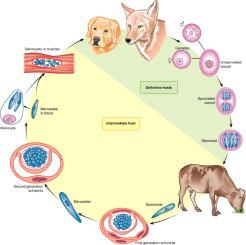International Journal for Parasitology ( IF 3.7 ) Pub Date : 2022-12-01 , DOI: 10.1016/j.ijpara.2022.09.009 J P Dubey 1 , B M Rosenthal 1

|
Infections by Sarcocystis in cattle are ubiquitous worldwide. There is considerable debate concerning the identity of Sarcocystis spp. in cattle. Proper diagnosis of Sarcocystis spp. is important to assess their economic and public health importance. Currently there are seven named species: Sarcocystis hirsuta, Sarcocystis cruzi, Sarcocystis hominis, Sarcocystis bovifelis, arcocystis heydorni, Sarcocystis bovini and Sarcocystis rommeli. Additionally, there are unnamed Sarcocystis spp. Two species, S. hominis and S. heydorni, are zoonotic. One out of seven species (S. hirsuta, contracted from cats) forms macroscopic cysts which can be visible during carcass inspection. Current molecular characterization is based on DNA extracted from sarcocysts from naturally infected cattle because DNA was not characterized from tissues of experimentally infected cattle or feces of experimentally infected definitive hosts. Sarcocystis cruzi (transmitted via canids) is recognized as the most pathogenic species and it causes abortion, low milk yield, poor body growth, and outbreaks of clinical sarcocystosis and death. Additionally, Sarcocystis infections have been linked to an inflammatory condition of striated muscles termed bovine eosinophilic myositis (BEM). Cattle affected by BEM appear clinically normal. Diagnosis of BEM at slaughter occurs when inspecting the carcass surface, or once the carcass has been divided into prime cuts or quarters. Sex and breed have no apparent influence on prevalence of BEM. The condition evidently occurs with equal frequency in steers, cows, and heifers. Virtually all striated muscles can be affected including skeletal muscles, the muscles of the eye, larynx, and the heart. In the USA, regulations require condemnation of BEM-affected parts, or (in severe cases) the entire carcass. These aesthetic considerations result in economic losses. Cattle experimentally infected with Sarcocystis did not have BEM at slaughter. Here, we review the status of Sarcocystis spp. and BEM in cattle including prevalence, lesions, epidemiology, and association of BEM with different species of Sarcocystis.
中文翻译:

牛肉孢子虫病:肉孢子虫种类、诊断、患病率、经济和公共卫生考虑因素,以及肉孢子虫种类与牛嗜酸性肌炎的关联
牛肉孢子虫感染在全世界范围内普遍存在。关于肉孢子虫属的身份存在相当多的争论。在牛中。肉孢子虫属的正确诊断。对于评估其经济和公共卫生重要性非常重要。目前有七个命名种:Sarcocystis hirsuta、Sarcocystis cruzi、Sarcocystis hominis、Sarcocystis bovifelis、arcocystis heydorni、Sarcocystis bovini和Sarcocystis rommeli。此外,还有未命名的肉孢子虫属。人型链球菌和海多链球菌这两个物种是人畜共患的。七分之一的物种(S. hirsuta,从猫身上感染)形成肉眼可见的包囊,在尸体检查过程中可以看到。目前的分子表征是基于从自然感染的牛的肉囊中提取的 DNA,因为 DNA 没有从实验感染的牛的组织或实验感染的最终宿主的粪便中进行表征。克氏肉囊虫(通过犬科动物传播)被认为是致病性最强的物种,它会导致流产、产奶量低、身体生长不良以及临床肉囊虫病和死亡的爆发。此外,肉孢子虫感染与称为牛嗜酸性肌炎(BEM)的横纹肌炎症有关。受 BEM 影响的牛临床表现正常。屠宰时 BEM 的诊断是在检查屠体表面或将屠体分割成主要部分或四份后进行的。性别和品种对 BEM 的患病率没有明显影响。显然,这种情况在阉牛、母牛和小母牛中发生的频率相同。事实上,所有横纹肌都会受到影响,包括骨骼肌、眼部肌肉、喉部肌肉和心脏。在美国,法规要求对受 BEM 影响的部分或(在严重情况下)整个尸体进行谴责。这些美观考虑会导致经济损失。实验性感染肉孢子虫的牛屠宰时没有 BEM。在这里,我们回顾了肉孢子虫属的现状。牛中的 BEM,包括患病率、病变、流行病学以及 BEM 与不同种肉孢子虫的关联。































 京公网安备 11010802027423号
京公网安备 11010802027423号